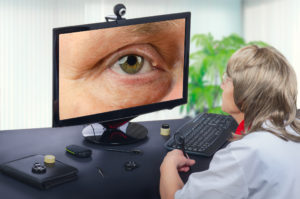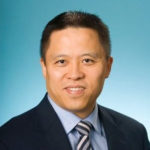By Gary Y. Chu, OD, MPH, FAAO,
Vice-President, Professional Affairs,
New England College of Optometry (NECO)

March 1, 2023
The pandemic has taught us that telemedicine can be used to meet the needs of our patients, but it has also led to many questions and concerns that need to be addressed. The core technology of telemedicine integrates distance communication between the doctor and the patient, as well as remote acquisition of healthcare data.
In the Fall of 2022, NECO hosted its second Industry Collaborative, where representatives from all sectors of the ophthalmic industry, including American Optometric Association and Association of Schools and Colleges of Optometry (ASCO), engaged in an open and honest discussion about refraction in telemedicine.
The presenters included Joseph Kvedar, MD, President of the American Telemedicine Association; Terri Gossard, OD, Trustee of the AOA; Howard Fried, OD, Founder and President of DigitalOptometrics; Steven Lee, OD, MBA, an entrepreneur with a medical and engineering background; and Shivang Dave, PhD, Co-Founder and President of PlenOptika. Each panelist shared their perspectives for five minutes, followed by a spirited and frank discussion with the audience.
Other Articles to Explore
There is no doubt that remote care, facilitated by telemedicine, is a disruptive innovation that has been brought about by the melding of ubiquitous telecommunication with advances in electronic, objective methods of acquiring eyecare data. This disruption had occurred for decades, but its acceleration increased dramatically with the introduction of the iPhone in 2007 and the forced adoption during COVID. Using examples from other sectors – both in and outside of healthcare – Dr. Kvedar highlighted that patients, as consumers, seek quality healthcare with good service delivered when they need it.
During COVID, eyecare professionals found ways to provide eyecare for their patients. The components of an eyecare evaluation have a complex interaction that may trigger different prioritization of the components of this evaluation. Hence, it is vital to break each component down in order to discuss the core tenets of each portion of an eye/vision care evaluation.
Each member of the panel referenced the importance of quality care, which is the core competency of improving the quality of health for patients. However, they all emphasized how complex it is to implement. It’s important not to place a higher standard of care on telemedicine as compared to an in-person exam. A doctor critically analyzes the data in front of them to decide on how to proceed in the care process. This may include additional tests, a discussion of their goals and options, a treatment plan with an in-person or remote follow-up appointment, or referrals to other specialists. The care process is dynamic and fluid, but the doctor-patient relationship remains at its core.
Two big takeaways from this discussion
It is no surprise that the panelists’ opinions differ in the tempo and extent of the deployment of technology in the healthcare process. In the case of refraction, these points include:
- Can we disaggregate the exam so that more patients can be seen, since uncorrected refractive care is a public health crisis? We can see more patients and deal with uncorrected refractive error more efficiently, but do we sacrifice too much and create potential harm?
- Eyecare is not just refraction. But can the safe parts be more transactional, and ocular health and disease conditions be dealt with differently?
There was also a diversity of perspectives and passion emanating from the audience, creating a healthy tension and discussion, which swiftly swung from one position to another.
The discussion emphasized the core issues that need to be addressed and studied, including the following:
- Explore what components of eyecare may be transactional.
- Define a gold standard for the eye exam, but apply it equally for in-person and telemedicine encounters.
- Study outcomes of a telemedicine exam in the context of quality and impact.
- Assess potential collateral damage between telemedicine and in-person exams.
- Chart proper paths for various types of telemedicine exams, understanding that technology will improve.
- What can we learn from other healthcare and non-healthcare sectors?
- Think as a consumer while operating as a clinician.
In closing, the obvious interest in the impact of telemedicine demonstrates the need for a strategy to integrate technology into remote eyecare. The tension signals the need for pertinent issues to be discussed, researched and studied. The expansion of telemedicine in our society will require changes in the delivery of care to make it accessible, but also will create a proper balance where the delivery of care is managed appropriately by the doctor to meet patients’ needs, while delivering high-quality care with excellent health outcomes and extraordinary service.
 Gary Y. Chu, OD, MPH, FAAO, is Vice-President, Professional Affairs, at New England College of Optometry. and the direction of the NECO Innovation Center. To contact him: chu@neco.edu
Gary Y. Chu, OD, MPH, FAAO, is Vice-President, Professional Affairs, at New England College of Optometry. and the direction of the NECO Innovation Center. To contact him: chu@neco.edu

























